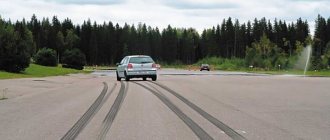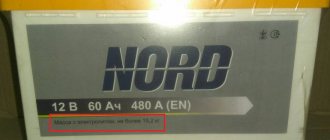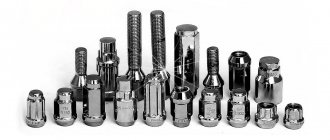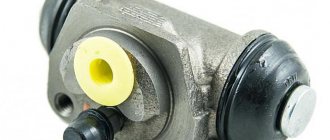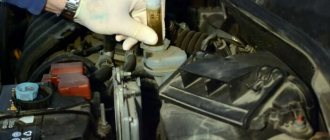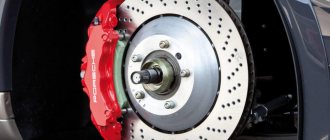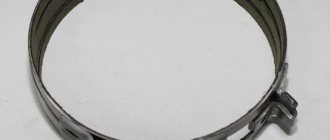What does braking distance depend on?
The indicator under consideration is not a constant value and can vary for a number of reasons. All factors influencing the braking distance can be divided into two large groups: driver-dependent and driver-independent. Reasons beyond the control of the person driving include:
- road condition;
- weather.
It is easy to guess that in rain, snow or ice, the distance required to stop a car will be greater than on dry asphalt. Braking will also take a long time when driving on smooth asphalt, to which stone chips have not been added. Here the wheels have nothing to catch on, unlike rough surfaces.
Note: it is worth noting that poor quality of the road (potholes, potholes) does not lead to an increase in the distance required to stop. The human factor plays a role here. Trying to save the suspension, drivers rarely reach high speeds on such roads. Accordingly, the braking distance here is minimal.
Factors depending on the driver or owner of the car:
- brake condition;
- system design;
- presence of ABS>;
- type of tires;
- vehicle load;
- movement speed.
The fact that the length of a car’s braking distance directly depends on the serviceability of the braking system does not require proof. A car with a malfunctioning brake circuit or worn out pads will never be able to stop as quickly as a working vehicle.
A lot depends on the design of the brake units. Modern cars equipped with rear disc brakes and brake assist systems have much better traction and shorter braking times.
In turn, the presence of EBD with ABS does not always help reduce the distance required to stop. On dry hard surfaces, where wheel locking occurs only with very intense braking, the system actually shortens the braking distance. However, on bare ice, the “smart” electronic assistant begins to reduce braking force even when you lightly press the brake pedal. At the same time, the car retains controllability, but its braking distance increases significantly.
What determines the rate of deceleration? Of course, it depends on the type of tires. So, on bare, albeit frozen, asphalt, as well as in slushy snow, the so-called brakes are best. “Velcro” are winter tires that are not equipped with studs. In turn, in icy conditions and on snowy roads, studded tires are the most effective. An important factor influencing the size of the stopping distance is the speed and load of the machine.
It is clear that a lightweight car at a speed of 60 km/h will stop faster than a truck loaded to capacity and moving at a speed of 80-100 km/h. The latter will not be allowed to stop quickly by speed and inertia that is too high for him.
When and how measurements are taken
Braking distance calculations may be required in the following cases:
- technical testing of the vehicle;
- checking the capabilities of the car after modifying the brakes;
- forensic examination.
As a rule, the formula S=Ke*V*V/(254*Fs) is used in the calculation. Here S is the braking distance; Ke – braking coefficient; V₀ — speed at the start of braking; Фс – coefficient of adhesion to the coating.
The coefficient of road adhesion varies depending on the condition of the surface and is determined according to the following table:
| Road condition | Fs |
| Dry | 0.7 |
| Wet | 0.4 |
| Snow | 0.2 |
| Ice | 0.1 |
The Ke coefficient is a static value and is unity for all the most common passenger vehicles.
Example: how to calculate the braking distance of a car when the speedometer shows 60 km/h in the rain? Given: speed 60 km/h, braking coefficient – 1, adhesion coefficient – 0.4. We count: 1*60*60/(254*0.4). As a result, we get the figure 35.4, which is the braking distance in meters.
The table shows how many meters the car will continue to move until it comes to a complete stop. It should be taken into account that no other indicators are taken into account (turns, potholes on the road, oncoming traffic, etc.). It is doubtful that in real conditions on an icy road, a car will be able to slide for a kilometer without encountering a pole or bump stop.
| Speed | Dry | Rain | Snow | Ice |
| km/h | meters | |||
| 60 | 20,2 | 35,4 | 70,8 | 141,7 |
| 70 | 27,5 | 48,2 | 96,4 | 192,9 |
| 80 | 35,9 | 62,9 | 125,9 | 251,9 |
| 90 | 45,5 | 79,7 | 159,4 | 318,8 |
| 100 | 56,2 | 98,4 | 196,8 | 393,7 |
| 110 | 68 | 119 | 238,1 | 476,3 |
| 120 | 80,9 | 141,7 | 283,4 | 566,9 |
| 130 | 95 | 166,3 | 332,6 | 665,3 |
| 140 | 110,2 | 192,9 | 385,8 | 771,6 |
| 150 | 126,5 | 221,4 | 442,9 | 885,8 |
| 160 | 143,9 | 251,9 | 503,9 | 1007,8 |
| 170 | 162,5 | 284,4 | 568,8 | 1137,7 |
| 180 | 182,2 | 318,8 | 637,7 | 1275,5 |
| 190 | 203 | 355,3 | 710,6 | 1421,2 |
| 200 | 224,9 | 393,7 | 787,4 | 1574,8 |
We found an interesting calculator that not only calculates the indicator depending on the speed and condition of the road, but also clearly shows the whole process.
How to increase the intensity of deceleration
From the above, it became clear what is called the braking distance and what this indicator depends on. However, is it possible to reduce the distance required to stop a car? Maybe! There are two ways to do this - behavioral and technical. Ideally, the driver combines both methods.
- Behavioral method - you can reduce the braking distance if you choose a low speed on slippery and wet roads, take into account the degree of load of the car, and correctly calculate the braking capabilities of the car depending on its condition and model year. Thus, a Moskvich developed in 1985 will not be able to brake as effectively as a modern Hyundai Solaris, not to mention more respectable and technologically advanced models.
- Technical method - a method of enhancing braking capabilities, based on increasing the power of the braking system and the use of auxiliary mechanisms. Manufacturers of modern vehicles actively use such methods of improving brakes, equipping their products with anti-lock braking systems, braking assistance systems, using more efficient brake discs and pads.
It should be remembered that reducing the time required to stop is one of the ways to ensure a safe trip. Therefore, every driver must constantly monitor the technical condition of his “iron horse”, promptly maintain and repair the braking system. In addition, it is important to choose the driving speed taking into account the surrounding situation: time of day, road condition, car model, etc.
Braking distance formula
Formula for finding braking distance
The formula for finding the braking distance is used in traffic police departments. This is what is used in our calculator. In this formula:
S - braking distance,
Kt - braking coefficient (for a passenger car is equal to 1),
V is the vehicle speed,
Ksc is the adhesion coefficient.
Concepts and explanations
The braking distance is the distance a car travels from the moment the brake mechanism is applied until the car comes to a complete stop. It is influenced by:
- condition and type of road surface,
- car tire condition,
- initial speed of the car,
- vehicle weight,
- serviceability of the brake system.
Stopping distance is the distance from the moment the danger is detected until the vehicle comes to a complete stop. It is clear that the braking distance is included in the stopping distance. In addition, the stopping route includes:
- the distance traveled by the car from the moment the danger was detected until the brake pedal was pressed;
- the distance traveled by the vehicle during the braking system activation.
The first parameter depends on many factors, the determining one of which is the driver’s reaction time. According to the results of numerous experiments, it can vary from 0.3 to 1.5 seconds . On average, the driver's reaction time can be considered to be 1 second. In addition, there is the concept of “normative time for perceiving a complex situation” equal to 0.8 seconds. It has also been established that the reaction time for women when a difficult traffic situation arises can reach 2.5-3 seconds, while for men it is 1.5-2 seconds. In addition, the reaction time is affected by:
- driver experience,
- his emotional state
- age,
- time of day and weather conditions,
- taking medications,
- state of alcoholic or other intoxication,
- the location of the hazardous situation.
The response time of the brake system depends on its type and technical condition. The brake system with a hydraulic drive operates in 0.2 - 0.3 seconds, with a pneumatic drive in 0.5 -0.6 seconds.
Concept of car braking distance
Braking distance is the distance covered by a car from the start of braking (the moment the drive is activated) to a complete stop.
What factors affect braking distance?
Human life is priceless. In an emergency situation (accident), braking distance is a decisive factor that cannot be ignored. Because every meter can cost a life.
Study the factors that affect stopping distance. This knowledge will help you stay healthy and avoid accidents:
- the driver will take timely measures to reduce speed,
- the pedestrian will have the opportunity to assess the safety of the crossing.
1) Condition of car tires . Tires are one of the most important elements of a wheel. They ensure safety while the vehicle is moving.
When choosing a tire, you need to pay attention to the tread height. What is a protector? This is a tire element. It protects the tire from damage and punctures. Correctly selected tires will ensure good vehicle control.
The vehicle's road grip indicator directly depends on the technical condition of the tread. There is a wide range of tires on the market. The tread depth is 5–17 mm.
In this case, you need to separate winter and summer tires:
- The tread of winter tires is 8.5–9.5 mm.,
- The tread of summer tires is 7.5–8.5 mm.
Based on the results of the experiments, it was found that when the tread wears out, the braking distance of the car increases significantly. The tread wears out during use. Therefore, the friction force is significantly reduced.
In winter, be sure to use only winter tires. Whereas in the summer - summer tires. This will ensure optimal machine control. To make winter tires, special soft rubber is used.
Such products have deep grooves and a ribbed pattern. These features provide excellent grip in the winter season. And for the manufacture of summer tires, hard rubber is used.
2) Condition of the brake system . This system is designed to stop the car, as well as to reduce the speed of movement. This is one of the most important systems in the car. Because it provides security.
Let's consider point 2.3.1. Traffic rules It is prohibited to drive a vehicle with faulty brakes. A malfunction of this system results in loss of vehicle braking efficiency.
It is imperative to take into account the response time of this system. According to the requirements, the response time is no more than 0.6 s.
Let's consider the factors that affect the response time:
- system design,
- type,
- state,
- quality.
The length of the braking distance depends on the response time of this system.
3) Initial speed of the vehicle . The higher your speed, the longer the path will be.
4) Road surface.
5) Machine condition.
6) Weather conditions.
7) Braking method:
- stepwise pressing (full wheel locking),
- intermittent pressing (the vehicle stops quickly, and control may be lost),
- gradual increase in pressure (used in good visibility and in a calm environment),
- pressing hard until it stops (this method can lead to uncontrolled wear).
Driver skills . An experienced driver will be able to quickly navigate in an emergency situation.
Reaction Path
The reaction path is the distance the car has traveled from the moment you notice the danger to the moment you start to brake or turn.
The reaction path depends on:
- Vehicle speed. The reaction path is directly proportional to the speed: 2 times the speed = 2 times the reaction path.
- Reaction time. The normal human reaction time is 0.5 – 2 seconds. Reaction time is influenced by driver experience, age, condition and many external factors. Typically, the best reaction time is experienced drivers, aged 45 - 54 years.
The reaction path can be significantly shortened if you:
- Anticipate a dangerous situation.
- Keep your eyes on the road and be ready for action.
The reaction path can be significantly increased if
- the driver has to make a choice between actions (for example, between braking and turning)
- the driver is under the influence of alcohol, drugs or medication
- the driver is tired
Reaction Path Calculation
Let's say a car is moving at a speed of 50 km/h and the reaction time is 1.5 seconds.
- Convert km/h to m/s. 50 + 10% = 55 55 / 4 = 13.75 m/s
- We multiply the speed (in m/s) by the time (in seconds) to get the distance traveled. 13.75 * 1.5 reaction path = 20.625 meters.
When and how measurements are taken
Braking distance calculations may be required in the following cases:
- technical testing of the vehicle;
- checking the capabilities of the car after modifying the brakes;
- forensic examination.
As a rule, the formula S=Ke*V*V/(254*Fs) is used in the calculation. Here S is the braking distance; Ke – braking coefficient; V₀ — speed at the start of braking; Фс – coefficient of adhesion to the coating.
The coefficient of road adhesion varies depending on the condition of the surface and is determined according to the following table:
| Road condition | Fs |
| Dry | 0.7 |
| Wet | 0.4 |
| Snow | 0.2 |
| Ice | 0.1 |
The Ke coefficient is a static value and is unity for all the most common passenger vehicles.
Example: how to calculate the braking distance of a car when the speedometer shows 60 km/h in the rain? Given: speed 60 km/h, braking coefficient – 1, adhesion coefficient – 0.4. We count: 1*60*60/(254*0.4). As a result, we get the figure 35.4, which is the braking distance in meters.
The table shows how many meters the car will continue to move until it comes to a complete stop. It should be taken into account that no other indicators are taken into account (turns, potholes on the road, oncoming traffic, etc.). It is doubtful that in real conditions on an icy road, a car will be able to slide for a kilometer without encountering a pole or bump stop.
Safe distance between cars
According to clause 13.1 of the Traffic Rules, the driver must keep a sufficient distance from the vehicle in front that will allow him to brake in time.
Failure to maintain distance is one of the main causes of transport accidents.
When a vehicle in front comes to a sudden stop, the driver of a car closely following him does not have time to brake. The result is a collision between two and sometimes more vehicles.
To determine the safe distance between cars while driving, it is recommended to take an integer speed value. For example, the speed of a car is 60 km/h. This means that the distance between him and the vehicle in front should be 60 meters.
Emergency braking
Emergency (emergency) braking is used when there is a danger of a collision or collision.
You should not press the brake too sharply or too hard - in this case, the wheels will lock, the car will lose control, and it will begin to skid along the road.
Symptoms of locked wheels during braking:
- the appearance of wheel vibration;
- reducing vehicle braking;
- the appearance of a scraping or squealing sound from tires;
- The car has skidded and does not respond to steering movements.
IMPORTANT: If possible, it is necessary to perform a warning brake (half a second) for cars following behind, release the brake pedal for a moment and immediately begin emergency braking.
Types of emergency braking
1. Intermittent braking - press the brake (without allowing the wheels to lock) and release completely. Repeat this until the machine stops completely.
When you release the brake pedal, you need to align the direction of movement to avoid skidding.
Intermittent braking is also used when driving on slippery or uneven roads, braking before potholes or icy areas.
2. Step braking - press the brake until one of the wheels locks, then immediately release the pressure on the pedal. Repeat this until the machine stops moving completely.
When you release pressure on the brake pedal, you need to align the direction of movement with the steering wheel to avoid skidding.
3. Engine braking on cars with a manual transmission - press the clutch, change to a lower gear, use the clutch again, etc., alternately lowering to the lowest.
In special cases, you can lower the gear not in order, but several at once.
4. Braking with ABS: if a passenger car has an automatic transmission, during emergency braking it is necessary to press the brake with maximum force until it comes to a complete stop, and on cars with a manual transmission, simultaneously press hard on the brake and clutch pedals.
When the ABS system is activated, the brake pedal will twitch and a crunching sound will appear. This is normal, you should continue to press the pedal as hard as you can until the car stops.
PROHIBITED: During emergency braking, use the parking brake - this will lead to the car turning around and uncontrolled skidding due to the complete blocking of the car's wheels.
Concept of car braking distance
I remember something about the braking distance of a car from a school physics course, but that was so long ago that it doesn’t even look much like the truth anymore. Although drivers should be well versed in this concept. It refers to the distance the car travels from the moment the braking begins until the vehicle comes to a complete stop. Confusion arises with stopping and braking distances. These concepts are often confused and considered interchangeable. This is absolutely not true.
By stopping we mean the distance covered by the driver from the moment he realized the need to stop until the vehicle completely stopped moving. It turns out that the distance spent on braking is an integral part of the stopping distance. We have found out what is called the braking distance; now we need to understand the factors on which this indicator depends.
Different braking conditions
Let's consider the following conditions:
- wet asphalt, snow, ice,
- dry asphalt.
Dry asphalt
On dry asphalt, the tire's adhesion coefficient is 0.7–0.8. This is an excellent indicator.
Wet asphalt, ice, snow
On wet asphalt the coefficient of adhesion is 0,4–0,5.
Determining car speed using braking distance
It is quite difficult to calculate using the formula. To determine the speed of the car, you can use special online calculators. You can find such an online calculator in a search engine.
Online calculators are designed taking into account all requirements. They take into account all the data and formulas.
You only need to enter the following data:
- braking trace length,
- type of road surface,
- vehicle load level,
- car type,
- movement speed.
Next, the online calculator will do all the work for you.
Now let's look at the formula for determining the speed of movement. Formula : 0.5 x t3 x j + √2Syu x j.
Description:
- Syu is the length of the trace,
- j - this symbol indicates the deceleration of the vehicle when braking,
- t3 is the increase in deceleration of the car,
- Va is the initial speed of the machine.
Braking distance of a car at a speed of 60 km/h
Body deformation in a collision at a speed of 60 km/h
The length of the stopping distance also depends not only on the driver, but also on other related factors: the quality of the road, speed, weather conditions, the condition of the brake system, the design of the brake system, vehicle tires and many others.
Please note that the weight of the car does not affect the braking distance . This is due to the fact that the weight of the car increases the inertia of the car when braking, thereby preventing braking, but increases the grip of the tires on the road due to the increased weight of the car.
These physical properties compensate each other, while having virtually no effect on the braking distance.
The braking speed directly depends on the braking method. A sharp brake all the way will cause the car to skid or skid (if the car is not equipped with an ABS system).
Gradual pressure on the pedal is used when there is good visibility and a calm environment on the road, it is not suitable for emergency situations. If you press intermittently, you can lose control, but you can stop quickly. Stepwise pressing is also possible (similar in effect to the ABS system).
Braking distance on dry asphalt
Braking distance formula
Let's remember physics lessons, where ? is the coefficient of friction, g is the acceleration due to gravity, and v is the speed of the car in meters per second.
The situation is as follows: a driver is driving a Lada car whose speed is 60 km/h. Literally 70 meters away is an elderly woman, who, forgetting about safety rules, hastily catches up with a minibus (a standard situation for Russia).
Let's use this very formula: 60 km/h = 16.7 m/sec. Dry asphalt has a friction coefficient of 0.7, g – 9.8 m/s. In fact, depending on the composition of the asphalt, it is from 0.5 to 0.8, but let’s take the average value.
The result obtained from the formula is 20.25 meters. Naturally, this value is appropriate only for ideal conditions, when the car is equipped with high-quality tires and brake pads, the brake system is working properly, and when braking you do not skid or lose control, due to many other idealized factors that do not occur in nature.
Also, to double-check the result, there is another formula for determining the braking distance :
S = Ke * V * V / (254 * Fs), where Ke is the braking coefficient, for passenger cars it is equal to one; Fs – coefficient of adhesion with coating 0.7 (for asphalt).
We substitute the vehicle speed in km/h.
It turns out that the braking distance is 20 meters for a speed of 60 km/h (for ideal conditions), if the braking is sharp and without skidding.
Braking distance on surface: snow, ice, wet asphalt
BMW cars on test
The friction coefficient helps indicate the length of the stopping distance under different road conditions. Coefficients for different road surfaces :
- Dry asphalt – 0.7
- Wet asphalt – 0.4
- Rolled snow – 0.2
Let's try to substitute these values into the formulas and find the braking distance values for the road surface at different times of the year and under different weather conditions :
- Wet asphalt – 35.4 meters
- Rolled snow – 70.8 meters
- Ice – 141.6 meters
It turns out that on ice the braking distance is almost seven times higher than on dry asphalt (as well as the substitutable coefficient). The length of the braking distance is affected by the quality of winter tires and physical properties.
Testing has shown that with the ABS system, the stopping distance is significantly reduced, but still, in icy and snowy conditions, ABS does not affect, but rather worsens braking efficiency when compared with a braking system without ABS. However, in ABS, to a large extent, everything depends on the settings and the presence of a brake force distribution system (EBD).
The advantage of ABS in winter is complete control over vehicle control, which minimizes the occurrence of uncontrolled skidding when braking. The principle of operation of ABS is similar to the implementation of stepped braking on cars without ABS.
The ABS system reduces braking distance on: dry and wet asphalt, compacted gravel, road markings
On ice and compacted snow, the use of ABS increases the braking distance by 15 - 30 meters, but allows you to maintain control over the car, without the car going into a skid. This fact should be taken into account.
What is braking distance and examples of calculations
This concept means the distance that the car covered after the start of braking until it came to a complete stop. It is necessary to distinguish between the concepts of normal and emergency braking.
The value of the normal braking distance in meters shows the square of the vehicle speed divided by 10.
For example, if you start braking at a speed of 60 km/h, the car will stop after 36 meters.
During emergency braking, the driver fully presses the brake pedal, and in this case the distance is determined using a different formula. The speed of the car at the moment of braking, divided by 10, is multiplied by the same value, halved.
For example, when driving around the city at a speed of 50 km/h, in case of an emergency stop the braking distance will be 12.5 meters. Calculation: (50 km/h/10) x (50 km/h/10)/2 = 12.5 (meters).
The braking distance is directly affected by the driver's reaction time, during which the car will travel a certain distance before braking begins.
To calculate this value, you need to multiply (speed in km / h / 10) by three. For example, when driving at a speed of 120 km/h in case of sudden danger, the driver's reaction will be (120 km/h/10) x 3 = 36 (meters).
Stopping distance means the total distance that a car travels from the moment a danger is detected until it comes to a complete stop. To determine it, you need to add the driver’s reaction time to the formula for calculating the normal braking distance.
What factors influence braking and stopping distance?
Speed
This is the key factor. This means not only the speed of the car, but also the reaction speed of the driver. It is believed that everyone has approximately the same reaction, but this is not entirely true. Driving experience, a person’s health status, medication use, etc. play a role. Also, many reckless drivers ignore the law and are distracted by smartphones while driving, which ultimately can lead to catastrophic consequences.
Remember one more important point. If a car's speed doubles, its braking distance quadruples! The 1:1 ratio doesn't work here.
Road conditions
Undoubtedly, the length of the brake line is influenced by the condition of the road surface. On an icy or wet road it can increase significantly. But these are not all the factors. You should also be wary of fallen leaves, on which tires glide perfectly, cracks in the surface, holes, and so on.
Tires
The quality and condition of the rubber greatly influence the length of the brake line. Often, more expensive tires provide better grip on the road surface. Please note that if the tread depth has worn off beyond the permissible value, then the rubber loses its ability to drain a sufficient amount of water when driving on a wet road. As a result, you may encounter such an unpleasant thing as hydroplaning - when the car loses traction and becomes completely uncontrollable.
To shorten the braking distance, it is recommended to maintain optimal tire pressure. Which one exactly - the automaker will answer this question for you. If the value deviates upward or downward, the braking line will increase.
Depending on the coefficient of adhesion of the tires to the road surface, this indicator will vary. Here is a comparative table of the dependence of the braking distance on the quality of the road surface (a passenger car whose tires have an average coefficient of adhesion):
| 60km/h. | 80 km/h. | 90 km/h. | |
| Dry asphalt, m. | 20,2 | 35,9 | 45,5 |
| Wet asphalt, m. | 35,4 | 62,9 | 79,7 |
| Snowy road, m. | 70,8 | 125,9 | 159,4 |
| Ice, m. | 141,7 | 251,9 | 318,8 |
Of course, these indicators are relative, but they clearly illustrate how important it is to monitor the condition of car tires.
Technical condition of the machine
A car can only go on the road in good condition - this is an axiom that does not require proof. To do this, carry out routine diagnostics of your car, make timely repairs and change the brake fluid.
Remember that worn brake rotors can double the brake line.
Distraction on the road
While the vehicle is moving, the driver has no right to be distracted from driving the vehicle and monitoring the traffic situation. Not only its safety, but the lives and health of passengers, as well as other road users, depend on this.
Here's what happens in a driver's brain when an emergency occurs:
- assessment of the road situation;
- making a decision - to brake or maneuver;
- response to the situation.
Depending on the driver's innate abilities, the average reaction speed ranges from 0.8 to 1.0 seconds. This setting concerns an emergency situation, rather than an almost automatic process when slowing down on a familiar stretch of road.
To many, this time period seems insignificant to pay attention to, but ignoring the danger can lead to fatal consequences. Here is a table of the relationship between the driver’s reaction and the distance traveled by the car:
| Vehicle speed, km/h. | Distance until the brake is pressed (the time remains the same - 1 second), m. |
| 60 | 17 |
| 80 | 22 |
| 100 | 28 |
As you can see, even a seemingly insignificant second of delay can lead to dire consequences. That’s why every motorist should never break the rule: “Don’t be distracted and stick to the speed limit!”
Various factors can distract the driver from driving:
- mobile phone - even just to see who is calling (when talking on the phone, the driver’s reaction is identical to the reaction of a person in a state of mild alcohol intoxication);
- watching a passing car nearby or enjoying beautiful scenery;
- fastening the seat belt;
- eating while driving;
- falling of an unsecured DVR or mobile phone;
- clarification of the relationship between driver and passenger.
In fact, it is impossible to make a complete list of all the factors that can distract a driver from driving. In view of this, everyone should be attentive to the road, and passengers will benefit from the habit of not distracting the driver from driving.
How long does it take for the driver to react?
Different drivers have average reaction times, but the average is 0.5 seconds. But these data also show much longer times – up to 1.5 seconds.
So what does this time depend on?
- From the floor. In men, the reaction is more developed than in women.
- Age also directly affects the reaction . As statistics show, in older people the reaction occurs on average after a second, and in young people - less than half a fraction of the time.
- Experience. If an experienced driver needs a split second to make a decision, a beginner will spend some time thinking about making a decision and comprehending the situation.
- Conditions . In cities, the driver always sees changes, maintains different speeds, accelerates and brakes. On the highway, due to monotony, the reaction slows down.
- Time. At night, the reaction of all people becomes dull, and during the day it becomes faster.
- Weather conditions also affect the speed of reactions . If there is snow, rain, dust or fog outside the window, the driver is completely absorbed in this problem, and it takes a little longer to react.
- A mobile phone also increases time . It’s not for nothing that they fined people for talking without a special device.
- Medicines – if you are taking them, you need to consult your doctor to see if you can drive a car while taking them. Some medications dull the reaction and cause drowsiness.
Road conditions and vehicle movement
As already mentioned, road conditions and weather conditions significantly affect the movement and braking of a vehicle. On a slippery road, conditions are created for the car to slip, skid and skid.
| Braking distance of a passenger car | ||
| on the asphalt | on ice | |
| 30 km/h | 6 meters | 17 meters |
| 60 km/h | 23 meters | 69 meters |
| 90 km/h | 52 meters | 156 meters |
In order not to get stuck when driving on loose snow, you need to select a lower gear in advance and move without stopping or making sharp turns.
When driving in icy conditions, you should drive through slippery sections of the road without braking or sharp turns of the steering wheel, without using the clutch pedal. If it is necessary to reduce speed, you need to use engine braking as much as possible, which does not lead to skidding and skidding of the car.
It is important to know! When hitting a slippery surface with only one side of the car (for example, the right wheels), any braking and sharp turn of the steering wheel can lead to a skid.
When it starts to rain after a long period of dry weather, the road becomes very slippery because the accumulated dust turns into mud. Until the rain gets heavier and washes away the dirt from the roadway, you need to drive with the same caution as in icy conditions.
During heavy rain, a “water wedge” may appear under the wheels of a car moving at high speed, causing the car to stop obeying the steering wheel. In such conditions, you cannot reach a speed of more than 80 km/h.
If the car still loses control due to a water wedge, then only engine braking can be used to reduce speed. In this case, under no circumstances should you press the brake pedal, as this will immediately cause a severe skid.
A gust of strong side wind when leaving a closed section of the road into an open one (for example, from a forest into a field) can lead to a sudden change in the vehicle’s trajectory.
To increase stability, it is recommended to reduce the speed, switch to a lower gear, and, if necessary, level the trajectory using the steering wheel.
Brake system and its features
Each vehicle has its own time to stop. The brake system in the car sections works almost the same, the only difference is in the condition of the brake pads.
A certain vehicle will be able to stop for:
- Passenger cars – 12-13 seconds.
- Buses up to 5 tons – 13-14 seconds.
- Buses over 5 tons – 16-17 seconds.
- Trucks up to 3.5 tons – 15-16 seconds.
- Trucks from 3.5 to 12 tons – 17-18 seconds.
- Trucks weighing more than 12 tons – 17-18 seconds.
- Two-wheeled mopeds or motorcycles – 7-8 seconds.
- Motorcycle equipped with a trailer – 8-9 seconds.
- Passenger cars with a trailer – 13-14 seconds.
Traffic rules and speed
In order to keep the braking distance as short as possible and in accordance with the table above, you should adhere to the traffic rules and recommended speed.
- So, in populated areas you should not exceed the speed of more than 60 kilometers per hour, and in courtyards and residential areas you should not drive more than twenty kilometers per hour.
- For buses carrying children, there is a limit on all roads - sixty kilometers per hour.
- The same speed conditions must be observed for vehicles that have people sitting on special benches in the back. Buses, whether intercity or small, as well as motorcycles are allowed to travel no more than 90 kilometers per hour.
- All other buses, as well as category “B” cars that tow a trailer , can drive no more than 90 kilometers per hour on highways.
- The same rules apply to semi-trailer trucks. But on other roads these vehicles can travel no more than 70 kilometers per hour.
- Cars and trucks (if the gross weight does not exceed three and a half tons) can drive on highways at a speed of 110 kilometers per hour, and on all other roads - no more than 90 kilometers per hour.
